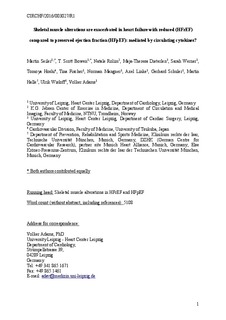| dc.description.abstract | BACKGROUND: A greater understanding of the different underlying mechanisms between patients with heart failure with reduced (HFrEF) and with preserved (HFpEF) ejection fraction is urgently needed to better direct future treatment. However, although skeletal muscle impairments, potentially mediated by inflammatory cytokines, are common in both HFrEF and HFpEF, the underlying cellular and molecular alterations that exist between groups are yet to be systematically evaluated. The present study, therefore, used established animal models to compare whether alterations in skeletal muscle (limb and respiratory) were different between HFrEF and HFpEF, while further characterizing inflammatory cytokines. METHODS AND RESULTS: Rats were assigned to (1) HFrEF (ligation of the left coronary artery; n=8); (2) HFpEF (high-salt diet; n=10); (3) control (con: no intervention; n=7). Heart failure was confirmed by echocardiography and invasive measures. Soleus tissue in HFrEF, but not in HFpEF, showed a significant increase in markers of (1) muscle atrophy (ie, MuRF1, calpain, and ubiquitin proteasome); (2) oxidative stress (ie, higher nicotinamide adenine dinucleotide phosphate oxidase but lower antioxidative enzyme activities); (3) mitochondrial impairments (ie, a lower succinate dehydrogenase/lactate dehydrogenase ratio and peroxisome proliferator-activated receptor-γ coactivator-1α expression). The diaphragm remained largely unaffected between groups. Plasma concentrations of circulating cytokines were significantly increased in HFrEF for tumor necrosis factor-α, whereas interleukin-1β and interleukin-12 were higher in HFpEF. CONCLUSIONS: Our findings suggest, for the first time, that skeletal muscle alterations are exacerbated in HFrEF compared with HFpEF, which predominantly reside in limb, rather than in respiratory, muscle. This disparity may be mediated, in part, by the different circulating inflammatory cytokines that were elevated between HFpEF and HFrEF. | nb_NO |
